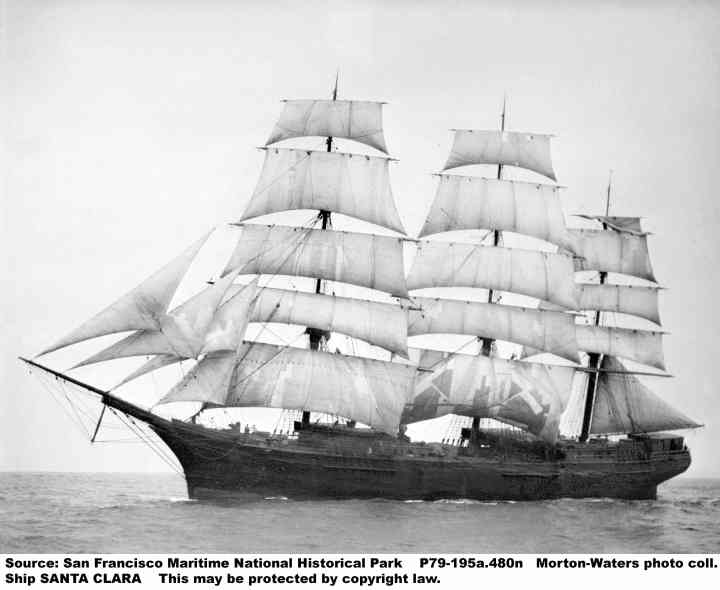
The Santa Clara isn’t an easy ship to get information on. Before my dive, I searched “high and low” and could only find one video on Vimeo and a comment by somebody about the ship sinking twice. I contacted that person and he referred me to Steve Lawson of California Wreck Divers website. Steve proved to be a invaluable resource and gave me a lot of information about the wreck. Almost all of the information below is directly from Steve.
History
The Santa Clara was a “downeaster” because the ships sailed up and down the coast (as opposed to across the ocean from Europe or elsewhere). The Santa Clara was launched in 1876 and was a wooden 3-mast ship built in Bath, Maine by Chapman & Flint. It was 209.5 feet long and a beam of 40 feet and had a gross tonnage of 1535. Here is a picture of the ship:

The Santa Clara ended up in San Francisco as part of the fleet of the Alaska Packers Association from 1896-1926. During the fishing season, thousands of men would sail up to to Alaska and fish for salmon and then return to San Francisco. They APA needed a fleet of inexpensive vessels to ferry men and supplies up and down the coast. Below is part of a document about the APA operating model and the wooden ships:
“Of particular note, the Alaska Packers Association from its inception began chartering sailing ships for the annual run to Alaska beginning in May of each year and terminating in September. Sailing ships were cheap to buy, cheap to manage, cheap to lay up—they were just cheap. Part of the Alaska Packers Association drive for profitability as before mentioned, was to control operating costs. Cheap labor and cheap transportation were part of that equation. The ships would sail north laden with cannery supplies, food, canning and casing materials, and also cannery hands (mostly Chinese) and fishers (often Italian). The voyages were slow and often hazardous. The work was intense and unremitting. No one was paid until the end of the season when they returned to San Francisco.”
At some point, the Santa Clara was sold and moved to Los Angeles where it was used in the movies and possibly as a fishing barge. At some point in the early 1930s, she sunk in the harbor. Several efforts were undertaken to salvage the ship in the 1950s. After several failed attempts to salvage the ship it was discovered that during the movie years, they had put thousands of ton of gravel for ballast. Norma Hanson and her husband realized this and removed the ballast and then tried to lift her by crane. They succeeded in raising the ship but then the Coast Guard told them to dump it off Palos Verdes, California. Dick Anderson was on board when they sank the Santa Clara around March 12, 1964 and noted the position of the ship.
Pictures
Today, the ship has mostly disintegrated. There is still some structure remaining and there is still a large debris field. The wreck lies in about 160 feet of water with almost no relief since it was wooden and has rotted away. Not many people dive this wreck.

Given that the wreck is mostly broken up, I just decided to post a gallery of random pictures.








Notes / References

I was with Steve on our first dive to the Santa Clara. It was dark and dirty, as is common at Pt. Fermin. I didn’t see anything interesting except hundreds of Tritonia festiva nudibranchs. When Steve surfaced he was very excited. Apparently, there were still a lot of portholes left. 🙂
Haha! Too funny.
We had decent visibility but there wasn’t much left of the wreck at this point. It was fun to do once but I probably wont’ dive it again.
– brett